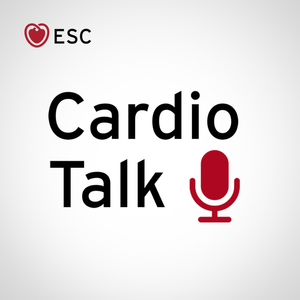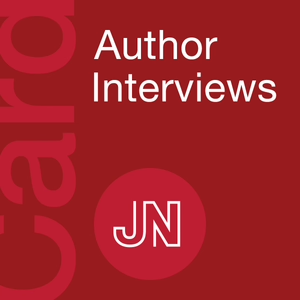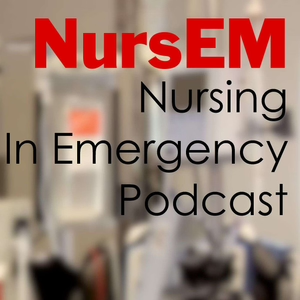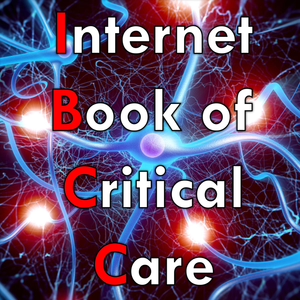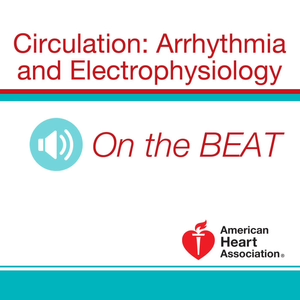
Circulation: Arrhythmia and Electrophysiology On the Beat August 2017
08/15/17 • 50 min
Dr. Wang: Welcome to the monthly podcast On The Beat for Circulation, Arrhythmia and Electrophysiology. I'm Dr. Paul Wang, editor-in-chief, with some of the key highlights from this month's issue. We'll also hear from Dr. Suraj Kapa, reporting on new research from the latest journal articles in the field.
This month's issue of Circulation: Arrhythmia and Electrophysiology has a number of fascinating and important articles. Let's start with the first article by Philip Halbfass and Associates, which describes the use of esophageal endoscopy in patients undergoing atrial fibrillation ablation. Of 1,802 patients undergoing afib ablation, 832 underwent post-procedural esophageal endoscopy. All patients were ablated using a single tip re-circular ablation catheter. Category one lesions described as erythema erosion were seen in 98 out of these 295 patients, while in 52 out of the 295 patients, ulceration was seen. In three of the 832 patients, esophageal perforation occurred, and in two of the 832 patients, atrial-esophageal fistula occurred.
Esophageal perforation only occurred in patients with category two lesions with an absolute risk of 9.6%. The authors concluded that post-ablation esophageal endoscopy is able to identify patients with high-risk lesions. One out of 10 patients with post-ablation esophageal ulcers progressed to perforation, while no patients without esophageal ulcers showed evidence of perforating complications.
In the next article by Christian Sohns and Associates describes the relationship between atrial fibrosis identified with magnetic resonance imaging and atrial rotor activity identified by noninvasive electrophysiological mapping. Ten patients underwent pulmonary vein isolation for persistent atrial fibrillation. Late gadolinium enhancement using magnetic resonance imaging, which projected onto the anatomy used for noninvasive electrophysiologic mapping.
The noninvasive electrophysiologic mapping identified 410 rotors evenly distributed between the left atrium and the right atrium. This study found that there was no statistically significant association between the presence of late gadolinium enhancement and the presence of rotors.
In the next article written by Jereon Venlet examines the endocardial unipolar voltage that best identifies abnormal epicardial electrograms. Thirty-three patients underwent endocardial epicardial right ventricular electro-anatomical mapping in ablation of right ventricular scar-related ventricular tachycardia. Eighty-six percent of abnormal epicardial electrograms had corresponding endocardial sites with bipolar electrogram less than 1.5 millivolts.
The remaining abnormal epicardial electrograms could be identified by endocardial unipolar voltages of less than 3.7 millivolts. The authors concluded that this use of endocardial unipolar voltage cut off at normal bipolar voltage sites improves the identification of all abnormal epicardial electrograms where there is less than 1 millimeter of fat.
The next article by Alan Bulava and Associates examines the outcomes of hybrid epicardial and endocardial radial frequency ablation, a persistent atrial fibrillation. Seventy patients underwent the epicardial thoracoscopic procedure followed by endocardial mapping ablation two to three months later. At the time of catheter ablation, 76% of patients were in sinus rhythm. All four pulmonary veins were found to be isolated in 69% of the patients and the left atrial posterior wall was isolated in 23% of the patients.
In the 12 months after the catheter ablation, 77% were arrhythmia-free, off antirrhythmic drugs. The majority of arrhythmia occurrences occur during the first 12 months following catheter ablation. Using previously ineffective antiarrythmics drugs and re-ablation procedures, arrhythmia-free survival increased to 97% during a mean followup of 936 days. Left atrial volume greater than 165 milliliters, the absence of sinus rhythm before catheter ablation and induce-ability of any sustained tachyarrhythmia at the end of catheter ablation predicted atrial fibrillation recurrence.
The authors concluded that the majority of patients after epicardial ablation required endocardial catheter ablation to complete the linear ablation or pulmonary vein isolation lesion sets. In the next article, Jason Roberts and Associates studied the clinical phenotype of Type 6 Long QT Syndrome, stemming from mutations in the KCNE2 encoded voltage gated channel beta subunit.
The authors examined individuals reported pathogenic KCNE2 mutations collected from inherited arrhythmia clinics in the Rochester LQTS registry as well as previously reported LQT6 cases identified through a med-line database search. Of 44 probands studied, 16 probands had resting QTC intervals and only developed QT prolongation and malignant arrhythmias following exposure to QT prolonging stressors. Ten had other Long QT pathogen...
Dr. Wang: Welcome to the monthly podcast On The Beat for Circulation, Arrhythmia and Electrophysiology. I'm Dr. Paul Wang, editor-in-chief, with some of the key highlights from this month's issue. We'll also hear from Dr. Suraj Kapa, reporting on new research from the latest journal articles in the field.
This month's issue of Circulation: Arrhythmia and Electrophysiology has a number of fascinating and important articles. Let's start with the first article by Philip Halbfass and Associates, which describes the use of esophageal endoscopy in patients undergoing atrial fibrillation ablation. Of 1,802 patients undergoing afib ablation, 832 underwent post-procedural esophageal endoscopy. All patients were ablated using a single tip re-circular ablation catheter. Category one lesions described as erythema erosion were seen in 98 out of these 295 patients, while in 52 out of the 295 patients, ulceration was seen. In three of the 832 patients, esophageal perforation occurred, and in two of the 832 patients, atrial-esophageal fistula occurred.
Esophageal perforation only occurred in patients with category two lesions with an absolute risk of 9.6%. The authors concluded that post-ablation esophageal endoscopy is able to identify patients with high-risk lesions. One out of 10 patients with post-ablation esophageal ulcers progressed to perforation, while no patients without esophageal ulcers showed evidence of perforating complications.
In the next article by Christian Sohns and Associates describes the relationship between atrial fibrosis identified with magnetic resonance imaging and atrial rotor activity identified by noninvasive electrophysiological mapping. Ten patients underwent pulmonary vein isolation for persistent atrial fibrillation. Late gadolinium enhancement using magnetic resonance imaging, which projected onto the anatomy used for noninvasive electrophysiologic mapping.
The noninvasive electrophysiologic mapping identified 410 rotors evenly distributed between the left atrium and the right atrium. This study found that there was no statistically significant association between the presence of late gadolinium enhancement and the presence of rotors.
In the next article written by Jereon Venlet examines the endocardial unipolar voltage that best identifies abnormal epicardial electrograms. Thirty-three patients underwent endocardial epicardial right ventricular electro-anatomical mapping in ablation of right ventricular scar-related ventricular tachycardia. Eighty-six percent of abnormal epicardial electrograms had corresponding endocardial sites with bipolar electrogram less than 1.5 millivolts.
The remaining abnormal epicardial electrograms could be identified by endocardial unipolar voltages of less than 3.7 millivolts. The authors concluded that this use of endocardial unipolar voltage cut off at normal bipolar voltage sites improves the identification of all abnormal epicardial electrograms where there is less than 1 millimeter of fat.
The next article by Alan Bulava and Associates examines the outcomes of hybrid epicardial and endocardial radial frequency ablation, a persistent atrial fibrillation. Seventy patients underwent the epicardial thoracoscopic procedure followed by endocardial mapping ablation two to three months later. At the time of catheter ablation, 76% of patients were in sinus rhythm. All four pulmonary veins were found to be isolated in 69% of the patients and the left atrial posterior wall was isolated in 23% of the patients.
In the 12 months after the catheter ablation, 77% were arrhythmia-free, off antirrhythmic drugs. The majority of arrhythmia occurrences occur during the first 12 months following catheter ablation. Using previously ineffective antiarrythmics drugs and re-ablation procedures, arrhythmia-free survival increased to 97% during a mean followup of 936 days. Left atrial volume greater than 165 milliliters, the absence of sinus rhythm before catheter ablation and induce-ability of any sustained tachyarrhythmia at the end of catheter ablation predicted atrial fibrillation recurrence.
The authors concluded that the majority of patients after epicardial ablation required endocardial catheter ablation to complete the linear ablation or pulmonary vein isolation lesion sets. In the next article, Jason Roberts and Associates studied the clinical phenotype of Type 6 Long QT Syndrome, stemming from mutations in the KCNE2 encoded voltage gated channel beta subunit.
The authors examined individuals reported pathogenic KCNE2 mutations collected from inherited arrhythmia clinics in the Rochester LQTS registry as well as previously reported LQT6 cases identified through a med-line database search. Of 44 probands studied, 16 probands had resting QTC intervals and only developed QT prolongation and malignant arrhythmias following exposure to QT prolonging stressors. Ten had other Long QT pathogen...
Previous Episode
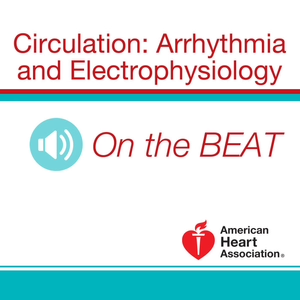
Circulation: Arrhythmia and Electrophysiology On the Beat July 2017
Dr. Paul Wang: Welcome to the monthly podcast, On The Beat for Circulation: Arrhythmia, and Electrophysiology. I'm Dr. Paul Wang, Editor in Chief, with some of the key highlights from this month's issue. We'll also hear from Dr. Suraj Kapa, reporting on new research from the latest journal articles in the field.
This month's issue of Circulation: Arrhythmia, and Electrophysiology has a number of groundbreaking and fascinating articles. Let's start with the first article by Christopher Andrews and Associates on the novel use of noninvasive electrocardiographic imaging in patients with arrhythmogenic right ventricular cardiomyopathy.
The authors compared 20 genotyped arrhythmogenic right ventricular cardiomyopathy patients to 20 control patients using electrocardiographic imaging, ECGI, a method for noninvasive cardiac electrophysiology mapping. They found that ARVC patients had a longer ventricular activation duration, with a mean of 52 milliseconds versus 42 milliseconds with a p-value of 0.007, as well as a prolonged mean epicardial activation recovery interval, a surrogate for local action potential duration with a median of 275 milliseconds versus 240 milliseconds with a p-value of 0.014.
In addition, the authors observed abnormal epicardial activation breakthrough locations with regions of nonuniform conduction and fractionated electrograms. These abnormal activation patterns correlated with late gadolinium enhancement using cardiac magnetic resonance scar imaging. This study suggests that electrocardiographic imaging may be a promising tool for the diagnosis and follow-up of patients with ARVC.
In the next article, Thomas Fink and Associates report the results of the prospective randomized Alster-Lost AF trial, comparing ablation strategies in patients with symptomatic persistent or long-standing persistent atrial fibrillation. The study compared standalone pulmonary vein isolation, the PVI-only approach, with a stepwise approach of PVI followed by complex fractionated atrial CFAE ablation and linear ablation, the substrate modification approach. Patients were randomized one-to-one to each study group. The primary study endpoint was freedom from recurrence of any atrial tachyarrhythmia at 12 months after a 90-day blanking period. 118 of 124 enrolled patients were analyzed. 61 in the p-value only group and 57 in the substrate modification group. The pulmonary vein isolation only group had a one-year freedom from arrhythmia recurrence of 54%, which was similar to the 57% recurrence rate in the substrate modification group, p = 0.86. Thus, this study confirms in a population of persistent and long-standing persistent atrial fibrillation that there is no significant benefit to the addition of CFAE ablation to pulmonary vein isolation only.
In the next paper, John Papagiannis and associates studied AV nodal reentrant tachycardia in patients with congenital heart disease. In this multi-centered, retrospective study, the authors compared catheter ablation of AV nodal reentrant tachycardia in 51 patients with complex congenital heart disease, with 58 patients with simple congenital heart disease.
There was no significant difference between the groups in terms of growth parameters, the use of 3D imaging, or type of ablation, radio frequency versus cryoablation. The procedure times, fluoroscopy times were longer in the complex group compared to the simple group. There were also significant differences between the groups in terms of acute success of ablation, 82% versus 97%; the risk of AV block, 14% versus 0%; and the need for chronic pacing, all significant in favor of the simple congenital heart disease group. There were no permanent AV block observed in patients who underwent cryoablation.
After a mean, 3.2 years of follow up, the long-term success was 86% in the complex group, and 100% in the simple group, p = 0.004. Thus, the authors concluded that the complexity of congenital heart disease affects the outcome of AV nodal reentrant tachycardia catheter ablation.
In the next paper, Moloy Das and associates studied whether the presence of abnormal intra-QRS peaks would indicate altered activation and might predict ventricular arrhythmias in cardiomyopathy patients. The authors examined the 99 patients with ischemic or nonischemic cardiomyopathy undergoing primary prevention ICD implantation, with a mean left ventricular ejection fraction of 27%. After a median follow up of 24 months, 20% of patients had arrhythmic events. Using a multivariate, Cox regression model that included age, left ventricular ejection fraction, QRS duration, and QRS peaks, only QRS peaks was an independent predictor of arrhythmic events with a hazard ration of 2.1. ROC analysis revealed that a QRS peak value of greater than or equal to 2.25 identified arrhythmic events with a greater sensitivity than QRS duration, 100% versus 70%, with p < 0.05, and a negative p...
Next Episode

Circulation: Arrhythmia and Electrophysiology On the Beat September 2017
Dr. Paul Wang : Welcome to the monthly podcast On the Beat for circulation, arrhythmia and electrophysiology. I’m Dr. Paul Wang editor in chief with some of the key highlights from this month’s issue. We’ll also hear from Dr. Suraj Kapa reporting on new research for the latest journal articles in the field.
The first article in this month's issue is by Yoav Michowitz and Associates who examine the morphological ECG characteristics of left posterior fascicular ventricular tachycardia and differentiated from right bundle branch block and left anterior hemiblock aberrancy. 183 ECGs with left posterior fascicular ventricular tachycardia in patients who underwent ablation were identified using a systematic Medline search were examined and compared to 61 ECGs with right bundle branch block in left anterior hemiblock aberrancy with no obvious cardiac pathology by echocardiography.
Using four variables including atypical right bundle branch block like V1 morphology, positive QRS in aVR, V6R greater than S ratio of less than one and QRS less than or equal to 140 ms, a prediction model was developed that predicted posterior fascicular ventricular tachycardia with a sensitivity of 82% and a specificity of 78%. Patients with three out of four positive variables had a high probability of having left posterior fascicular ventricular tachycardia whereas patients with less than or equal to one positive variable always had right bundle branch block plus left anterior hemiblock.
In the next article, Anna Thøgersen and associates describe a case series of 10 patients in whom implantable cardioverter defibrillators failed to treat ventricular tachyarrhythmias. The authors examine whether consensus derive generic rate threshold cutoffs between 185 and 200 beats per minute were employed in this case series. In nine patients, ventricular fibrillation did not satisfy program detection criteria. Five patients died with untreated ventricular fibrillation, four had cardiac arrest requiring external shocks and one was rescued by a delayed ICD shock. Seven of these patients had slowest detection rates that were consistent with generic recommendations but not tested in a peer review trial for their manufacturer’s ICDs.
In the reported cases, manufacturer specific factors interacted with fast detection rates to withhold therapy including strict ventricular fibrillation episode termination rules, enhancements to minimize T-wave over sensing and features that restrict therapy to regularly rhythms in VT zones. Untreated ventricular fibrillation despite recommended programming accounted for 56% of the deaths and 11% of all of deaths. The authors concluded that complex and unanticipated interactions between manufacturer specific features and generic programming can prevent therapy for ventricular fibrillation.
In the next article, Miguel Rodrigo and associates describe from 17 simulations of atrial fibrillation, atrial flutter and focal atrial tachycardia the ability to understand signal processing that can affect identification of reentrant activity using electrograms, body surface potential mapping and electrocardiographic imaging ECGI phase maps. Reentrant activity was identified by singularity point recognition and raw signals and in signals after narrow band pass filtering at the highest dominant frequency.
Reentrant activity was identified without filtering in 60% of unipolar records but filtering was required to increase reentrant activity detection from 1% to 62% in bipolar recordings. The filtering resulted in residual false reentrant activity in about 30% of bipolar recordings. The authors concluded that rotor identification is accurate and sensitive and does not require additional signal processing in measured or noninvasively computed unipolar electrograms while bipolar electrograms and body surface potential mapping do require highest dominant frequency filtering in order to detect rotors at the expense of a decrease specificity.
In the next article, Raymond Yee and associates examine the ability of a new automated antitachycardia pacing algorithm to reduce ICD shocks. The new automated ATP algorithm was based on electrophysiologic first principles and prescribed the ATP sequences in real time using the same settings for all patients. In 144 patients who had dual chamber or CRT ICDs as well as a history of one or more ICD treated VT or VF episodes or a recorded sustained monomorphic ventricular tachycardia episode. Detection was sent to ventricular fibrillation interval detection of 24 out of 32 ventricular tachycardia interval detection of 16 or greater in a fast VT zone of 242 to 320 ms.
There were 1,626 treated episodes in 49 patients over 14.5 month’s follow up. Data logs permitted adjudication of 702 episodes including 669 sustained monomorphic ventricular tachycardia episodes, 20 polymorphic ventricular tachycardia episodes, 10 SVT episodes and three ma...
If you like this episode you’ll love
Episode Comments
Generate a badge
Get a badge for your website that links back to this episode
<a href="https://goodpods.com/podcasts/circulation-arrhythmia-and-electrophysiology-on-the-beat-94401/circulation-arrhythmia-and-electrophysiology-on-the-beat-august-2017-5066125"> <img src="https://storage.googleapis.com/goodpods-images-bucket/badges/generic-badge-1.svg" alt="listen to circulation: arrhythmia and electrophysiology on the beat august 2017 on goodpods" style="width: 225px" /> </a>
Copy
